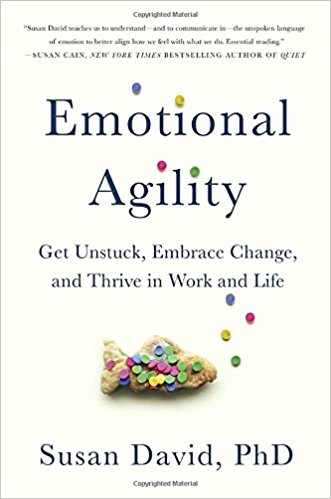What We're Reading Now
Develop Emotional Agility Part II
1 August 2017
Barbara read Emotional Agility: Get Unstuck, Embrace Change and Thrive in Work and Life and learned it’s important to face feelings before you distance yourself from them.
Tags: balance, barbara read, mindfulness
Allison first blogged about Emotional Agility: Get Unstuck, Embrace Change and Thrive in Work and Life by Susan David, PhD last fall, and it's been on my reading list ever since. In her book Emotional Agility, David says people usually do one of two things with emotions—try not to feel them or feel them too much. She uses the term bottlers for the first group and brooders for the second.
“Bottlers try to unhook by pushing emotions to the side and getting on with things. They’re likely to shove away unwanted feelings because those feelings are uncomfortable or distracting, or because they think that being anything less than bright and chipper is a sign of weakness, or a surefire way to alienate those around them.”
“When hooked by uncomfortable feelings, brooders stew in their misery, endlessly stirring the pot around, and around, and around….Brooding is a cousin of worry…Worry looks forward, brooding looks back.”
For most of my life I’ve indulged in brooding and its cousin worrying. I’d wallow in feelings, particularly negative and frightening ones, by rehashing them in my mind over and over. Lately, I’ve gotten better at denying and pushing away feelings (bottling) which I considered a good thing for some of the stresses in my life.
David says no to both approaches. She says for emotional agility, you must face your feelings, ask them questions because emotions give you information about what's important to you (your values), and problem solve before you distance yourself from them and move on.
She says one way to face your feelings is to write them down in a journal. I rejoiced because I do that every day. She quotes James Pennebaker who did 40 years of research on the benefits of writing in a journal. When you write your feelings and thoughts down “those thoughts are now out of you and on the page. You have begun the process of ‘slipping out’ from your experience to gain perspective on it.”

To find out what your emotions are trying to tell you, you need to think about what’s important to you. “Here are a few questions to ask yourself in order to start identifying your values:
- Deep down, what matters to me?
- What relationships do I want to build?
- What do I want my life to be about?”
Once again meditation and the resulting mindfulness are recommended to observe your feelings and thoughts before you let them go. I wish I had kept track of the number of books I’ve read that say meditation is good for you. Many times I have meditated every day for a week, sometimes a month, and then abruptly quit without even thinking about why. I decided to look up the definition of those terms in the New Oxford American Dictionary to remind myself exactly what they are.
“Meditation—think deeply or focus one’s mind for a period of time in silence or with the aide of chanting, for religious or spiritual purposes or as a method of relaxation.”
“Mindfulness—a mental state achieved by focusing one’s awareness on the present moment, while calmly acknowledging and accepting one’s feelings, thoughts, and body sensations.”
Mindfulness actually helps your brain do its work better. David’s research shows that “…mindfulness improves connectivity inside the brain’s networks that keeps us from being distracted. By helping us focus, mindfulness also increases competence. It improves memory, creativity, and our moods, as well as relationships, health and longevity in general. By paying attention to what’s going on around us, rather than ignoring it or just going along with the program, we can become more flexible and insightful.”
I’m going to start meditation again. I tend to develop a habit better if I assign it a time. I write in my journal each morning when I get out of bed and exercise most days at 4:30pm so I am picking 11:00am for meditation. Since one to five minutes is better than nothing, you might be able to do it at your desk without anyone noticing.
David says, “BEGIN WITH THE BREATH. For a full minute, do nothing but focus on your breath. Start by breathing in and out slowly, counting to four as you inhale, and counting to four as you exhale. Naturally, your mind will try to wander. Notice that and then just let it be. Don’t berate yourself for ‘not being good at this.’ Each time a thought pops into your head, just try to bring your focus back to your breath. That’s the whole game. It’s not about winning. It’s about engaging in the process.”
For more emotional agility, I hope you’ll try journal writing, asking questions of your emotions, and meditation. I’d love to see your comments if you do.







Comments
Our Comment Policy:
Our blog posts are only half of the conversation. What our readers have to say is equally important to us, and we're grateful for all the comments that continue the dialog.
To ensure that the discussion here is as useful as possible to all of our readers, please be respectful of our contributors and refrain from harassing, threatening and/or vulgar language. We reserve the right to screen and remove any comments from the site. If you have a question about a comment or want to discuss our policy, please contact us. We'll talk it over.
There are no comments for this entry yet.